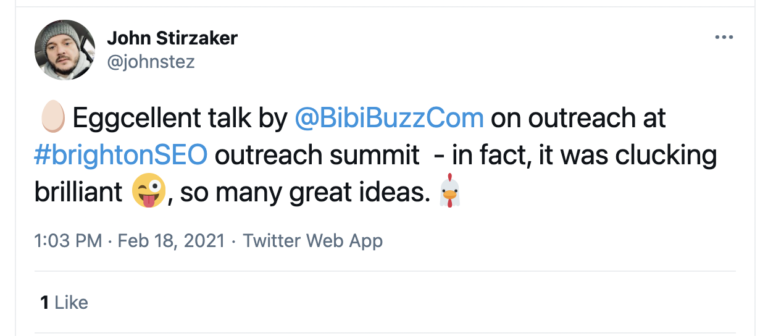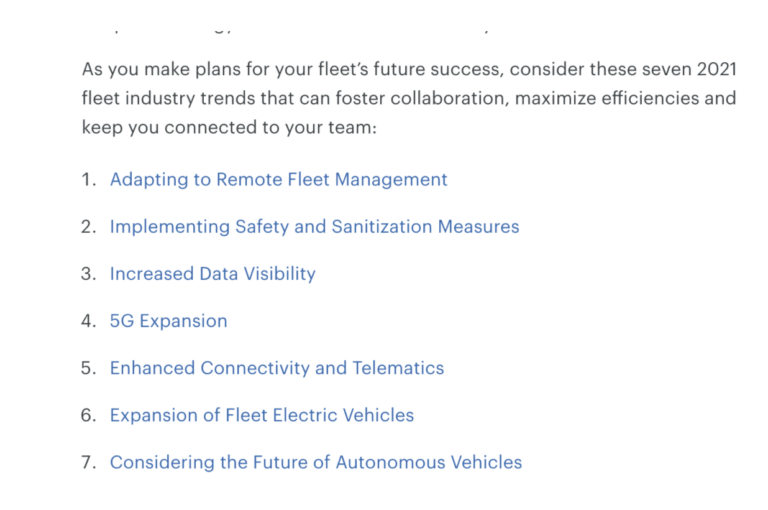The last time I talked about outreach, I had a chicken on my head.
I’m not kidding, look:

It wasn’t because I felt an irresistible longing for the cozy warmth of poultry coverage, but to bring home my main point:
Outreach, it’s how you say it.
I was presenting at the Outreach Summit and aside from feeling extremely flattered, I was super nervous.
Because if there is anything I find more boring than laundry, it’s watching online presentations and slides.
So, I decided to theme my talk with kittens and chickens.
Bit of a risk.
Luckily, folks appreciated the silliness and tweeted my slides, along with their own chicken puns:


Theming my talk made me stand out.
And by making people laugh, I created an instant personal connection with a remote, invisible audience.
This is exactly what you can do with your outreach, as well!
People get emailed by link builders constantly, and they’re so over it.
One way to still get the result you want is by changing how you write your email.
It involves two steps:
- Segmenting your prospect list.
- Theming your template.
Segmenting & Theming Your Outreach
When you’re building outreach-based links, you might struggle with finding the right balance between personalizing and scaling.
The more you personalize your email, the higher your conversion rate. This is simply because people tend to react well to someone who is genuinely interested in them.
It does take a lot of time and energy to write hyper-personalized or even bespoke emails.
And I don’t know about y’all, but I’ve been pretty exhausted lately.
On the flip side: the more generic your email, the easier it is to systemize and scale your outreach.
But your conversion rate will usually be lower.
You also run the risk of getting flagged for spam, as your email can miss the mark completely with your prospects.
Don’t despair though: there is a sweet spot between quality and quantity.
It’s where you tighten your prospecting to a specific segment, then create a template tailored to that exact audience.
Building Relationships
I’d like to pause here for a second, as a lot of emphasis in link building is placed on building relationships.
And it’s true; when you forge a relationship with an editor or the owner of a company, you can keep reusing them for links and other collaborations.
Which is totally awesome.
But not everyone has time for that, and some people feel hesitant on starting that journey for various reasons.
The next best thing is making a lightning-quick personal connection, especially when you’re cold-emailing.
Instant Personal Connection
It’s similar to how someone connects easily with a song, an image, or a movie quote.
Imagine you’re at a party talking to a stranger and five minutes in, you find out they also love RuPaul’s Drag Race.
You both start geeking out for the next hour just kiki-ing about how Symone slayed the runway and Kandi Muse threw shade at Utica and… you get the picture!
So, how do you make that quick connection with someone you don’t know?
First, you classify them into a very targeted category based on aspects like their topic angles, their audience, or their goals.
Then you research their language, interests, issues, etc.
And then you theme your outreach template accordingly.
Let’s unpack how that would work in real-life link building.
Segmenting Example
Let’s say you’re MACK Trucks, and you want to get more people interested in your new ecommerce platform for ordering parts.
As you don’t really have a great linkable asset, you decide to run a guest post campaign.
Now you need prospects to pitch content to.
Broad Prospecting
The most obvious way to build a prospect list is to look for sites that have content around trucks.
But in a list like that, you’d end up with a very diverse group: truck fans, truck sellers, truck repair services, logistics companies, environmental bloggers, and so on.
This would mean that your email can’t be too tailored, or else it might completely be mistargeted.
So you’d have to stick to a generic email, which can come off as disingenuous.
Narrow prospecting
When I prospect, I often use one or more of the following angles:
- Sites that rank on the keywords I’m targeting, for instance: [mack truck parts].
- Sites that are relevant to my customer’s journey, for instance: [fleet managers].
- Sites around topics that my audience is interested in, for instance: [road safety].
Once I’ve picked an angle, I Google around a bit and narrow my list down to a specific group.
In this case, I want to go for companies that offer fleet management software. I prefer to reach out to real businesses for two reasons:
- They monetize by selling products and services, not by selling links. If you pitch content that helps their audience, it has intrinsic value for them.
- They care about their site and their content for the long-term, and won’t just let anyone dump links for cash.
As an extra bonus, these prospects might end up as partners for other types of collaborations as well.
In the end, you share the same audience but you’re not competition, so it’s a win-win for all.
How to Find Prospects
In this example, I’m looking for fleet management software companies.
I always use Pitchbox to create Google Search Operator campaigns but you can just Google & scrape directly (SEOruler is an awesome free scraper).
Something that works well is to use keywords real software companies would rank for, such as [fleet management software inurl:demo].
This way, you bypass broader sites that review tons of software.

You can also look for existing lists, such as [Top 1000 Fleet Management Software].
Or even go all ninja and scrape software directories.
For another project, one member of my team went into a specific Shopify app category and grabbed all the companies that were listed there.
Quick Initial Quality Check
The prospect list you end up with should have mostly real companies targeting a section of your audience.
Before you start reaching out, you probably have to do a clean-up. Here’s a quick checklist.
Avoid sites that:
- Monetize with content only (except really big dog publishers).
- Look spammy or neglected.
- Are obvious link sellers.
- Scream WRITE FOR US.
Go for:
- Real companies & real people.
When replies come in, you can always dismiss a link prospect after reviewing how they reply, what their traffic and link behavior looks like, or any other quality metrics you use.
(If you have another favorite way of scraping or qualifying prospects, let me know in the comments.)
Theming Your Outreach
Now that you have a highly specialized list, you can do a bit of research to see what’s going on in that little corner of the web.
Questions you want to answer are:
- What lingo do they use?
- How do they write?
- What format of content do they have?
- What are their interests?
- What are their pain points?
- What’s currently going on in their niche?
- Which cultural inspiration is relevant to them: imagery, movies, music, quotes, puns etc.?
This sounds like a lot but thanks to Google, you can do this pretty quickly.
Theming Research Example
There are a lot of ways to dive into a segment, but whichever works for you is the best one.
I usually just Google back and forth in a creative flow, hopping from one topic to the next.
I call it “having a conversation with Google.”
Fleet management isn’t exactly the sexiest topic, but it can get interesting along the way.
Start by just searching for [fleet management trends 2021] and opening up some of the articles that pop up.

Make note of trends mentioned in the pieces if they sound suitable to use in an outreach email.
They could be used anywhere in the email, from the subject line to the send-off.
Here’s an example:

Topics I could use for inspiration are Remote Fleet Management or Safety and Sanitation Measures.
Perhaps this headline would work as a guest post pitch: “How to Implement Safety Protocols in Remote Fleet Management.”
While going through the SERP, I also noticed this piece:

Which made me think, “Fleet of the Future sounds catchy, let’s use that!” Of course, I noted it down.
So in short, while you’re going through the articles and search results, note down anything that jumps out at you as a usable element in your themed outreach email.
Make ‘Em Laugh
Another element that works really well is using humor in your emails.
It’s a great way to disarm any negative associations prospects have with getting outreached for links. It also enables you to instantly break the ice with a stranger.
Again, fleet management doesn’t sound hilarious from the get-go, but as people are passionate about their work, they often enjoy jokes about it, as well.
Even big deal editors of enterprise companies.
When I searched for “fleet management puns,” I found a list on Punstoppable:

The Quaker one is not the best of puns, but I could use it to stand out in an inbox.
For instance, the subject line could be the question, “What do you think Quaker calls their delivery fleet?”
And then when a prospect opens the email, I could give them the punch line: “Haulin’ Oats.”
When you do a quick and dirty deep-dive into the content and context of a narrowly targeted prospect list, you can use everything you encounter in your outreach email.
Here’s what your email could look like (and I hope yours is better than mine; my team does all of our templates so I’m kind of rusty):
Subject line: Your best fleet(ing) memory?
Hey Joe,
As 2020 is quickly disappearing from rear view, I’d like to turn the headlights on new challenges ahead for the audience of <site name>.
I was thinking something along these lines: How to Implement Safety Protocols in Remote Fleet Management, or maybe Fleet of the Future: Optimization for Last Mile Deliveries.
Happy to rephrase if you feel another angle is better suited, or take your suggestions for other topics you’d like me to cover.
Keep on truckin’,
Kirstie
If you don’t have the attention and creativity for this, you should delegate it to a copywriter.
I believe that copywriters are the best for outreach because they see the outreach email as a product in itself, not a means to an end.
And as I said earlier, it’s how you say it that helps you get the link.
Takeaway
Many link building strategies can work.
Whether they do or not depends a lot on the quality level of execution.
If you want to scale without losing quality, segmenting and theming can be your BFF.
So stop being basic, and start being a little bit more extra.
More Resources:
- 3 Alternative Link Building Tactics to Use Now
- 10 Modern Link Acquisition Tactics That Work
- Link Building for SEO: A Complete Guide
Image Credits
All screenshots taken by author, February 2021





![AI Overviews: We Reverse-Engineered Them So You Don't Have To [+ What You Need To Do Next]](https://www.searchenginejournal.com/wp-content/uploads/2025/04/sidebar1x-455.png)